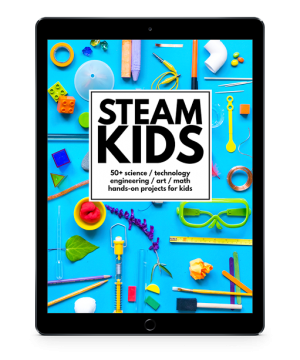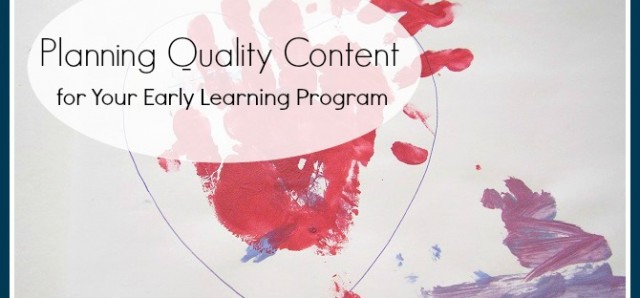Easy Method to Prepare Preschool Lesson Plans
Prepare your preschool, kindergarten, or toddler program in minutes with our convenient ABC Method. Compile and sort activities that will be available for scheduling when you need them.
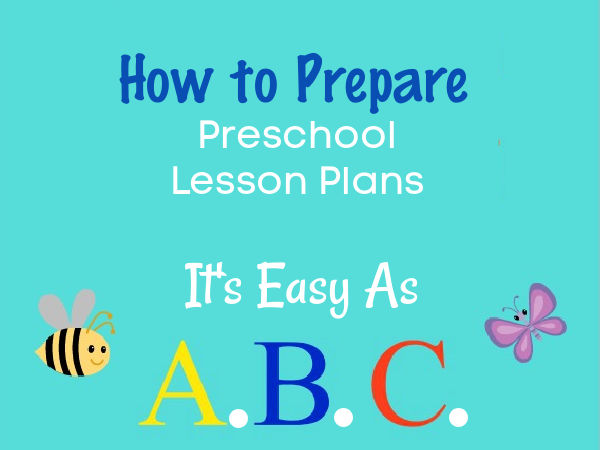
This post contains affiliate links. Privacy and Disclosure
Is planning your preschool program a welcome part of your weekly or monthly routine? Or is it a chore?
For many early learning teachers, it can be a bit of both. Finding just the right book or activity for your theme gives you a feeling of accomplishment, but it can also be time consuming.
You need a reliable system for gathering and storing ideas, a system that lets you create a lesson plan in no time.
The ABC Method can do the heavy lifting for you, compiling and scheduling daily activities with ease. Any steps you can take to make this job easier are a bonus, right?
As teachers and caregivers of early learners, your day is occupied with teaching, supervising, nurturing, and playing. A simple way to create lesson plans can be a game changer for your early learning program.
A.B.C Method for creating lesson plans
With the diversity of teachers and their students engaged in early education, no two early learning programs will be the same. But key components will be included in most early childhood environments.
These components are reflected in the the letters A.B.C., used to name our program planning method.
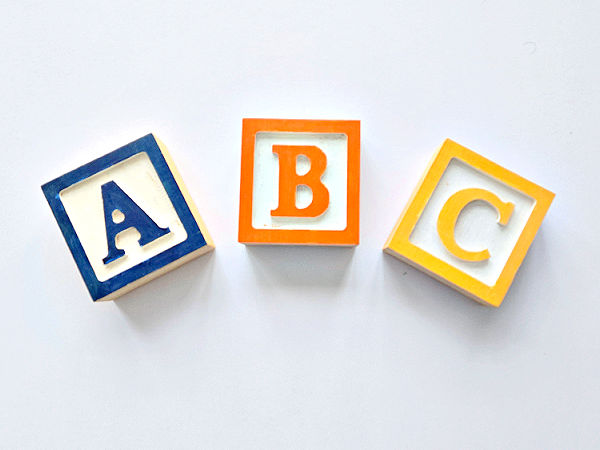
1. ABC method explained
A = Activity B = Book C = Craft
These general categories support early childhood development as kids play.
Each event within a category provides early learners with new or familiar experiences, in independent play or in small or large group settings.
Filling your daily planner requires both accessing and scheduling the events.
- Here are a few tips for searching for activities online.
- Daily schedules will vary according to teaching styles, early learning environments, time restraints, and ages, interests, and skill levels of the children.
Compiling and planning are the cornerstones of the ABC Method.
Here are the ABC categories explained in more detail.
Activities
This category can include a variety of play experiences that take place indoor or outdoor; in small or large groups; with or without props; engaging fine motor or gross motor skills.
Activities can be gross motor, such as indoor bowling, cognitive such as playing a memory card game, or fine motor, such as sorting shape cutouts on the felt board.
Activities may be introduced one on one or in a small or large group setting.
Books

This category can include a variety of literacy experiences: traditional story books; puppet shows; role playing; felt board activities.
Events can be teacher-led, such as a scheduled book reading at circle time, or child-led, creating stories with puppets during free play time.
While story time generally takes the form of a traditional book, a creative story telling method can be a fun alternative.
- For example, story time can be extended by role-playing The Three Bears after reading the book together.
Crafts

This category can include a variety of arts and crafts experiences: paints; craft materials; play dough.
Craft sessions provide opportunities for kids to imagine and create with a wide variety of art supplies and mediums.
- Include basic materials like paper and paint, glitter and glue, crayons and markers, as well as ribbon, yarn or stickers for more sensory and fine motor opportunities.
- Provide other mediums such as play dough, kinetic sand, and slime for additional creative play options.
Balance craft 'tutorials', that require following specific steps, with process art experiences, that require few or no instructions. This will provide kids with a variety of learning opportunities.
In all art sessions, promote the process and the not the product.
2. How to use the A.B.C. Method to create a lesson plan
The ABC method helps you find and schedule hands-on, engaging activities.
Program planning is made easy with just two steps!

Step 1. Compile content.
Find content.
- Create original content.
Carry a small notebook with you to jot down ideas anytime of day, or store on your mobile device. Add these ideas later to your resource file.
- Visit libraries.
- Purchase written material.
- Search online.
Organize content.
Create a storage system that is convenient for you.
- Store content as a hard copy in a 3-ring binder.
Here is a pdf option you can download and print to organize content. - Retain information in a digital spreadsheet.
This sample spread sheet shows how you can create thematic units and store content.
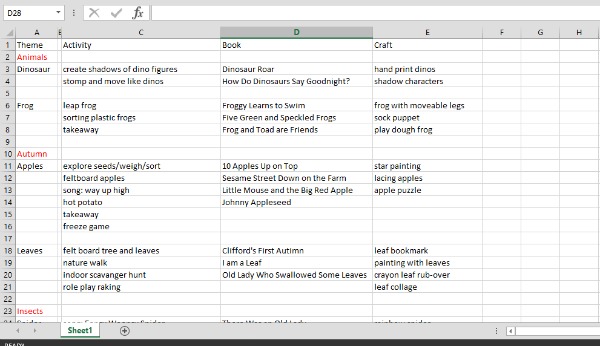
Tips for sorting content.
Sort content by theme or topic to organize activities.
a) Add columns in the Activity section to separate gross motor and small group activities.
b) Label each entry with a skill category such as fine motor, sensory, or math.
- This will show you at a glance the various learning skills that are being supported through everyday play.
c) Make a separate category for special events like field trips, or visitors to your center.
d) Add links or cite sources.
e) Include song lyrics or instructions for games.
f) Follow up any activity in a comments column, to alter or improve it in the future.
The categories - and columns - you create will depend on your preferences, and range of activities offered. You can start with broad categories such as 'seasons' and 'animals', then become more specific with sub-categories such as 'leaves' and 'dinosaurs'.
Add relevant content to your selected categories as you find or create content.
Step 2. Create a lesson plan.
Fill a weekly planner with stored content.
This editable planner can be edited or printed in Canva. It is filled for you with a Halloween theme.
How to use the planner:
- Specify a theme or topic, or choose a "general" category.
- Select activities from this category in your storage file.
- Add activities to a daily or weekly planner.
If you want to download and use as a printed chart multiple times, laminate or place under a transparent plastic cover that can be updated with a wipe-off marker.
3. Sample lesson plan created with ABC Method
Following is an example of how apple activities listed in the spread sheet can be inserted into a weekly planner using the ABC Method.

Apple Thematic Unit
Monday
Activity
Song (tune: I Love You, You Love Me)
Way up high, in a tree, Five red apples smiled at me. So I shook that tree as hard as I could, Down came the apples – mmm, mmm good!Book
Craft
Tuesday
Activity
Freeze game
- Place numbered cardboard apple shapes on the floor.
- Play music while kids walk in the spaces between the apples.
- When the music stops, each participant jumps on an apple and calls out the number.
- Alternately, ask "Who's on number 3?"
Book
Little Mouse and the Big Red Apple
Craft
Apple prints: Cut an apple in half through the middle to reveal a star. Dip the star in paint and stamp onto plain paper.
Wednesday
Activity
Take-away game
- Place several apples of different colors on the table. Cover with a cloth.
- Reach under the cloth to remove one apple without participants seeing which one is removed.
- Uncover the remaining apples. Guess which one is missing.
Book
Craft
Apple puzzle: Draw a large apple on cardstock. Color the apple. Cut the apple into several large pieces. Reassemble the pieces to complete the puzzle.
This is just a sample of what you can do with the ABC Method of program planning. The method is designed to be an easy way to create a lesson plan.
Here are links to some of the activities we've used in the spread sheet.
A.B.C Method for building weekly units
The ABC Method help you build content and create lesson plans so you can look forward to spending quality time with the kids - stacking blocks, planting seeds, and painting pictures.
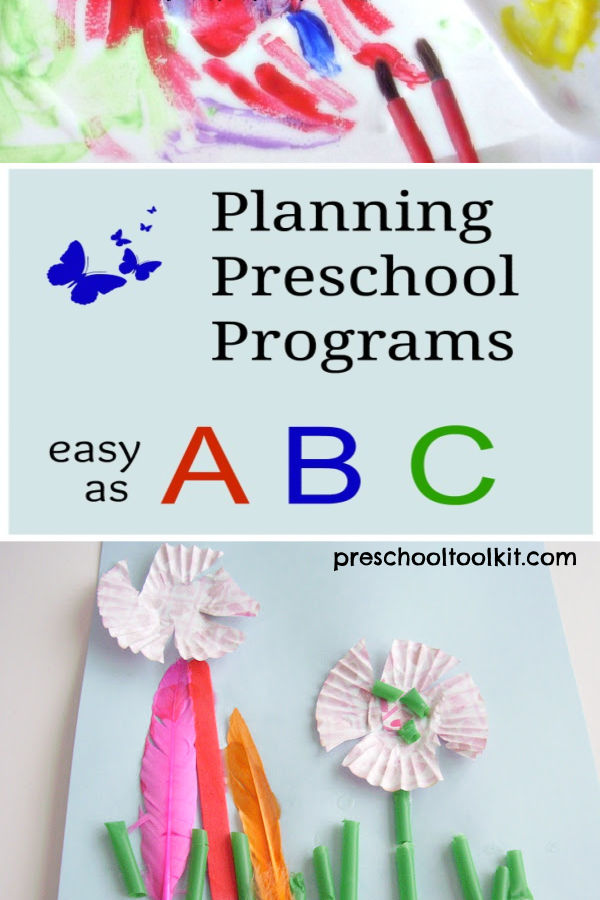
E-books with amazing content! (affiliates)
